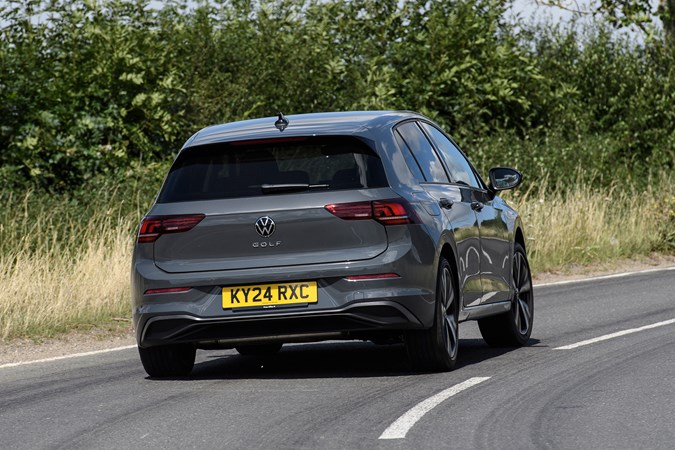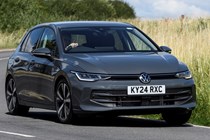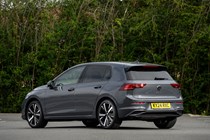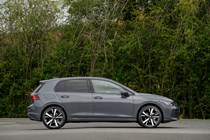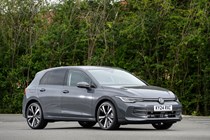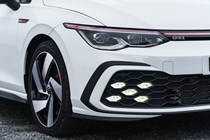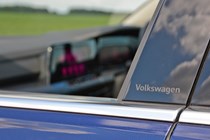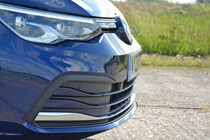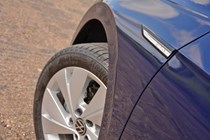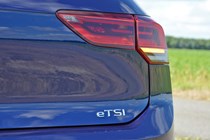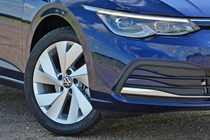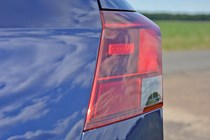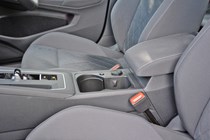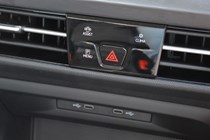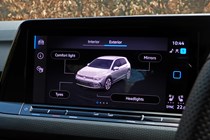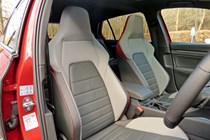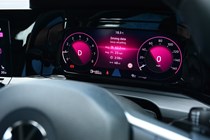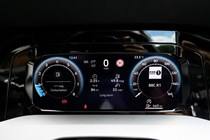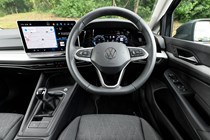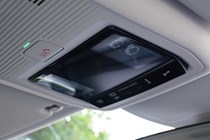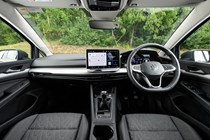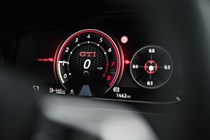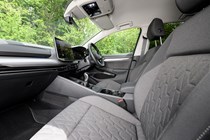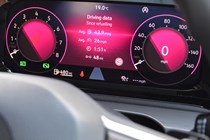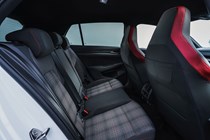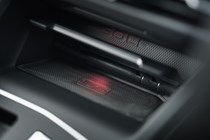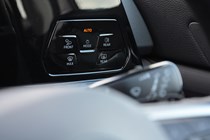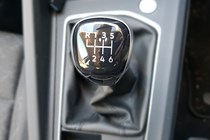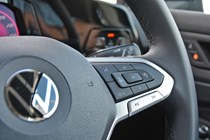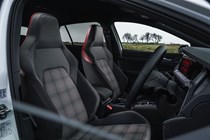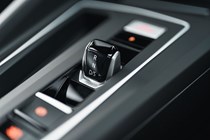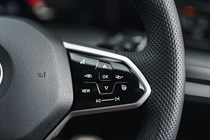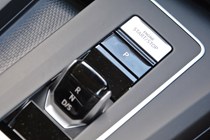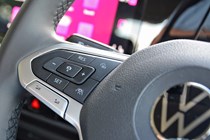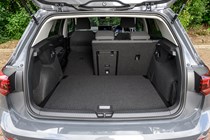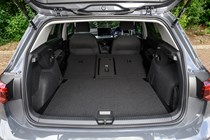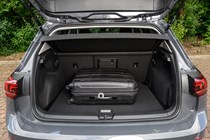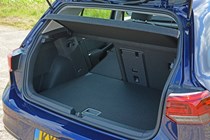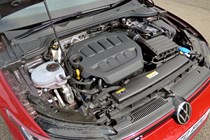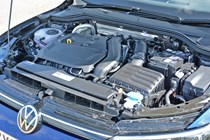
Volkswagen Golf engines, drive and performance
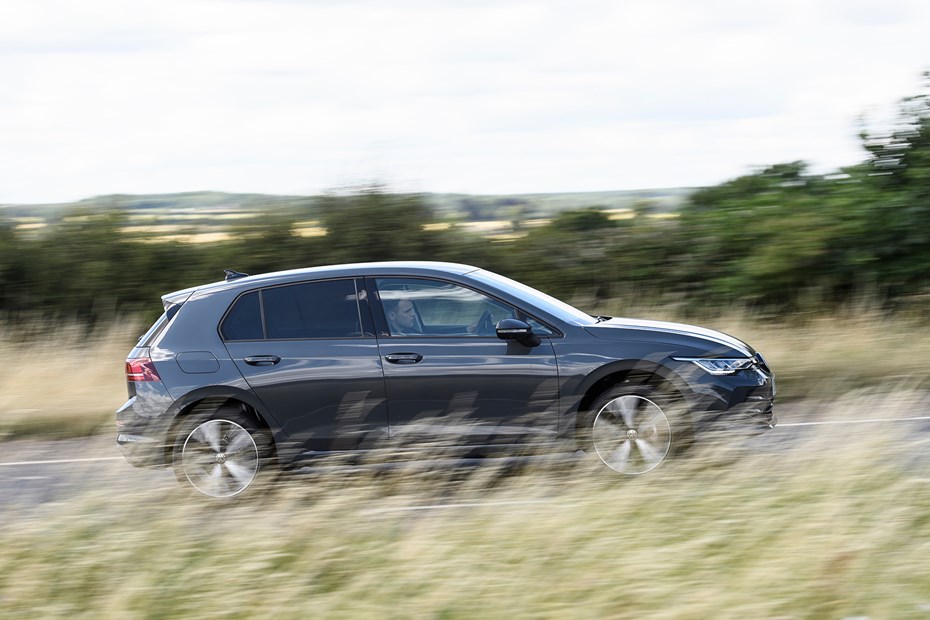
- The Golf still has a huge range of engines
- Choice of petrols, diesels and hybrid powertrains
- Performance versions come in several flavours
Petrol engines
Volkswagen has streamlined the Golf’s petrol engine range, ditching the pre-facelift model’s gutless 1.0-litre three-cylinder unit for a new, less powerful version of its 1.5-litre four-cylinder petrol engine.
This new engine produces 115hp. We’ll admit, that doesn’t sound like a significant improvement over the 110hp you got from the now defunct 1.0-litre unit – but it also has 220Nm of torque (pulling power). That’s 20Nm more than the 1.0-litre unit, which really helps to make the new entry-level Golf feel less like the poor relation.
Above that is another 1.5-litre engine in a familiar state of tune. It’s the same 150hp/250Nm unit fitted to everything from the pre-facelift Golf to the brand-new Tiguan – and it’s still a great performer. It’s got enough power to encourage you to step out for an overtake and it never feels out of its depth on the motorway.
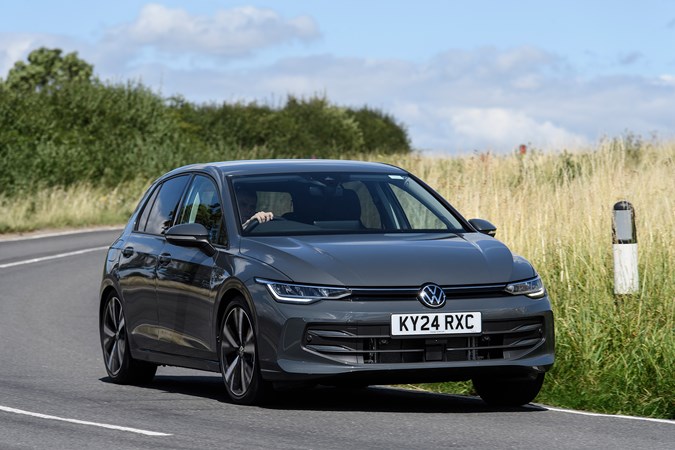
Both 1.5-litre engines are teamed with a six-speed manual gearbox as standard, and both are refined unless you push them hard. Spin them quickly to overtake or join a motorway slip road and both will sound quite coarse.
You can also specify both 1.5-litre engines with a seven-speed dual-clutch automatic gearbox as an optional extra – and the upgrade adds 48-volt mild hybrid assistance. The tech uses a special starter-generator and a dinky lithium-ion battery that’s charged by regenerative braking. The tech adds improves the engines’ efficiency by around 3mpg.
The mild hybrid eTSI units are a little brisker than the standard engine, especially when pulling away where there’s a grin-inducing burst of electrical assistance. The only problem is the slightly sleepy nature of the gearbox. It takes a while to shift, particularly when moving down its gears. You can, of course, change gears manually using the steering wheel paddles, which is much faster.
Diesel engines
When Volkswagen launched the Mk8 Golf in 2020, it introduced a brand new 2.0-litre four-cylinder diesel engine in two states of tune – 115hp and 150hp. Both diesel units are incredibly flexible and, because they can return an easy 70mpg on longer runs, you can eke 600 miles from a single tank of fuel.
The lower output diesel is a pleasant car to drive, and it impresses with its relaxed high-speed cruising ability and low noise levels. It doesn’t accelerate particularly briskly, but its healthy 300Nm torque figure means it isn’t fazed by inclines or heavy loads.
The 115hp model is only available with a six-speed manual gearbox and, the last time we drove it, we came away disappointed. It has a clunky, ever-so slightly obstructive change quality. Having said that, the car we drove had less than 2,000 miles on it, so it may well ease off with time. However, we reckon it’s just off-putting enough to force buyers towards the DSG.
That leads us nicely onto the 150hp model. It’s only available with Volkswagen seven-speed automatic and, in many ways, it’s all the Golf you’ll ever need. It has linear power delivery, bags of torque, strong in-gear acceleration and a nippy 0–62mph time of eight seconds flat. It’s quiet, too, helped by the fact it doesn’t need to be worked as hard as its lower powered brother.

Plug-in hybrid engines
There are two plug-in hybrid Golfs to choose from – the eHybrid and GTE. Both use Volkswagen’s 1.5-litre petrol engine as their starting point and both are teamed with an electric motor and a huge 19.7kWh battery pack.
That’s almost twice the size of the battery fitted to the pre-facelift plug-in hybrid Golf – and that means both powertrains now have an official maximum electric range of more than 80 miles.
The eHybrid produces 204hp (which is the same as the previous-generation Golf GTE) and has a 0–62mph time of 7.4 seconds, so it’s pretty brisk. Plus, it’s punchy enough to drive around in electric mode without making you ruddy faced with embarrassment.
Because it prioritises efficiency over performance, the eHybrid has a slightly longer electric-only range than the GTE. Thanks to Volkswagen’s improvements, it also has CO2 emissions of just 6g/km. That means it’s in the lowest company car tax bracket for combustion engine vehicles.
High-performance engines
Plug-in hybrid GTE
The Golf GTE combines the fuel efficiency of a plug-in hybrid with the performance of a hot hatchback. It has a more potent version of the eHybrid’s powertrain with 272hp – and the extra poke gives it a 0–62mph time of 6.6 seconds. You can read more about it in our dedicated Volkswagen Golf GTE review.
Golf GTI and Clubsport details
The GTI is traditionally the most popular fast Golf – and for good reason. Since it was introduced in the 1970s, it’s offered an excellent blend of straight-line speed and handling prowess. The latest model continues the formula.
It has a turbocharged 2.0-litre four-cylinder petrol engine with either 265hp in the standard GTI (which is an improvement over the pre-facelift car) or 300hp for the Clubsport. However, enthusiasts will be upset to learn that Volkswagen also ditched the manual gearbox for the updated GTI. You can learn more about the car by reading our standalone Volkswagen Golf GTI review.
Range-topping Golf R
At the top of the range is the Volkswagen Golf R. It has a more powerful version of the GTI’s engine with 333hp (compared to the pre-facelift car’s 320hp) and four-wheel drive. Volkswagen also has made a few tweaks the engine’s map and steering calibration.
We’ve driven a prototype version of the car, and we’re pleased to report that it’s noticeably better than the old car. Learn more about it by reading our dedicated Volkswagen Golf R review.
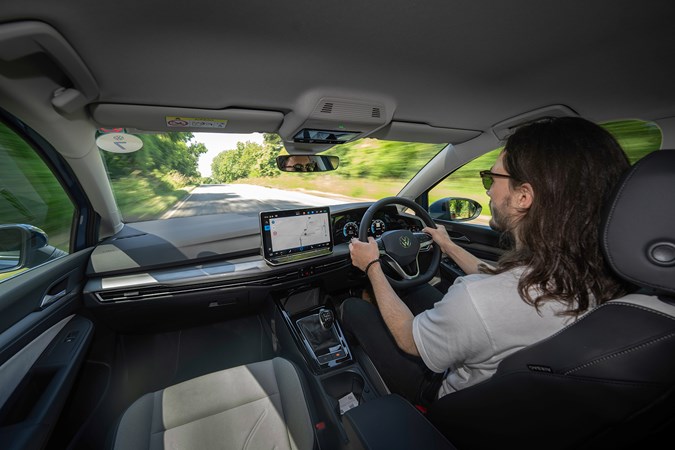
What’s it like to drive?
- Predictable handling and cooperative controls
- Comfortable ride (even for the sporty models)
- Manual gearbox adds some extra engagement
The Golf has long offered a great combination of comfort and tidy handling – and the current model is no exception. Even the most basic Life model (which does without clever tech such as adaptive dampers and Volkswagen drive mode selector) is sharp in the bends. Volkswagen’s passive dampers do a great job of controlling the car’s weight.
You can specify Volkswagen’s adaptive dampers as an optional extra, which can either firm up or slacken off the Golf’s ride to benefit ride quality or handling. Put simply, Volkswagen says the latest Golf is more comfortable at one end of the scale and sharper at the other.
The fancy suspension really does make a difference to the Golf’s driving experience, but we can’t really recommend you pay extra for it on any of the models in the standard car’s range. Its normal suspension is more than comfortable enough – and none of the Golf’s 1.5-litre petrol or 2.0-litre diesel engine are powerful enough to let you reap the benefits of the extra suspension stiffness. You really need to step up to the GTI or the R.
The Golf’s controls are very approachable. Its steering is direct and well-weighted, even in the car’s most basic trim – you can adjust the weight of the steering on higher-spec cars with the brand’s optional drive model selector. It doesn’t offer a great deal of feedback, but that’s a trait shared with cars across the Volkswagen Group.
Its pedals are very well-judged, too – especially in the manual-equipped models. The clutch is light enough to not be a chore around town but heavy enough to feel fun when you’re driving hard. Plus, we think the gear stick has a far more positive action than the unit found in the entry-level Vauxhall Astra.
But, unless you opt for the GTI or the R, the Golf is compromised. It was designed to be an all-rounder that can slot into everyone’s life (which it does very well). However, if you want a more focused driving experience, you might be better served by one of its rivals. The Ford Focus, for example, is far more talkative on a back road, while the Parkers award-winning Honda Civic is faster, more comfortable and sharper.
